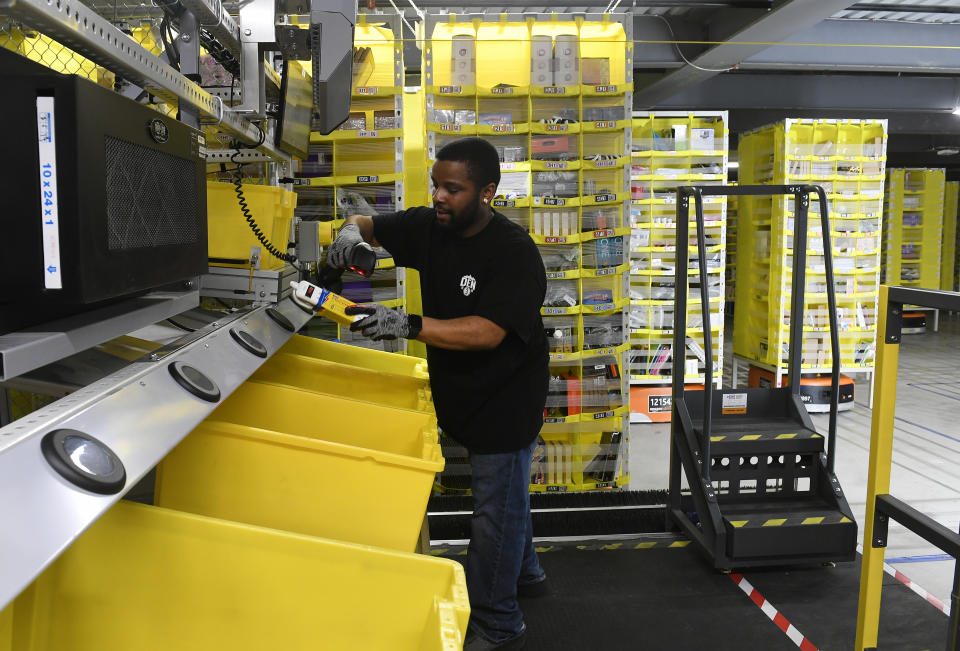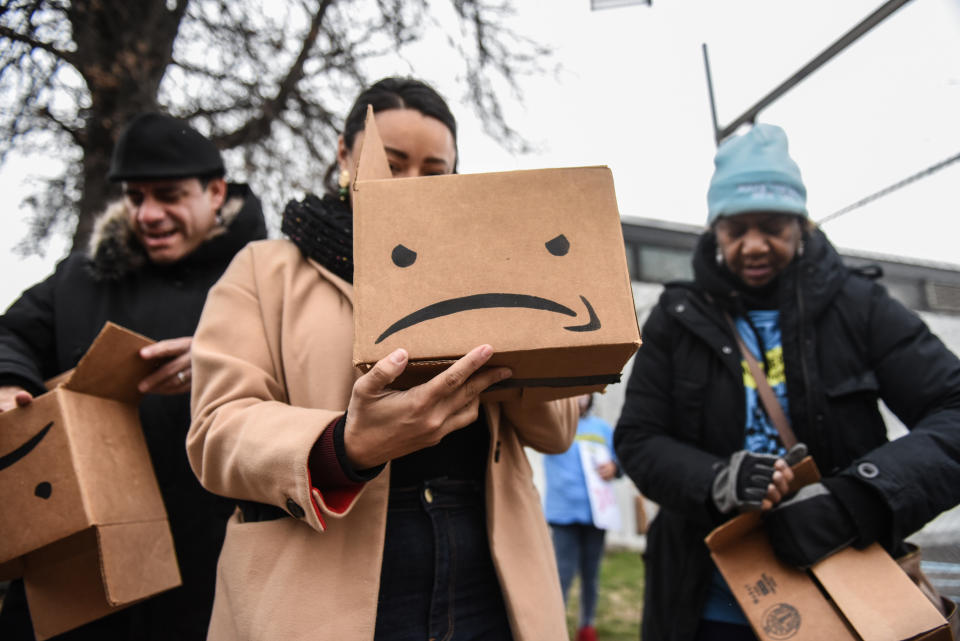Amazon warehouse worker injuries spike during the holidays, advocacy groups say
As holiday shopping ramps up at Amazon.com, so does the warehouse work required to fill every order — and the number of injuries that occur in the process, according to a report released on Monday by community advocacy groups.
The number of injuries per week at 28 facilities in 16 states increased significantly over the weeks between Black Friday and Christmas, reaching in mid-December a spike of about two-and-a-half times the annual average weekly injury rate, says the report, which draws on records over a four-year period kept by the Occupational Safety and Health Administration, or OSHA, a federal agency charged with enforcing workplace safety rules.
The findings come amid a surge in Amazon worker protests nationwide, from Sacramento to Chicago to New York City, as well as the launch last month of a national anti-Amazon coalition called Athena.
More than half of American households are expected to have an Amazon Prime membership by the end of the year, but a growing backlash against the company — led by progressive firebrands and fed up workers — has put its market power and warehouse conditions under scrutiny.
The report acknowledges that part of the uptick in the number of worker injuries per week over the holiday season is likely due to an increase in the number of warehouse workers employed over the holidays. In 2016 and 2017, for instance, the company reportedly nearly doubled its workforce over the holidays.
“We know in this culture that this is the time of year shopping kicks into highest gear,” Dania Rajendra, the executive director at Athena, tells Yahoo Finance. “It’s not a secret this is peak production time and that’s when people are under the most pressure to move as much merchandise as fast as possible.”
“All year around, the pace of work is a problem and that only gets worse at this time of year,” she adds.
In a statement, Amazon questioned the groups behind the report and reiterated its commitment to protecting workers.
“The report was developed and promoted by a collection of self-interested critics,” the statement says. “The fact is nothing is more important to us than safety — last year we provided more than one million hours of safety training to employees and invested more than $55 million on safety improvement projects, including ergonomic improvements.”
The rate of injuries at Amazon facilities does not increase over the holidays, the company added.
“The time of year does not change any individual performance expectations for associates in our Fulfillment and Delivery operations and it’s incorrect to assert that the holidays brings higher rates of injuries,” Amazon said. “It’s not about anyone working faster than they did previously; it’s about processes and our overall operations network coming together to be able to serve customers.”

‘This corporation is hurting us’
In addition to the spike in worker injuries over the holidays, the report found significant increases in the weekly number of 911 calls made from six facilities in the town of Hebron, Kentucky compared to the weekly number made from those facilities over the rest of the year, citing emergency call data for a period between 2017 and 2019.
In 2017, 13 emergency calls were made from the six facilities over the course of a week in mid-December; in 2018, 11 calls were made. These marked a significant increase from the average 3.8 calls per week over the 104 weeks for which the report collected data, said Debbie Berkowitz, Worker Health and Safety Program Director at the National Employment Law Project, who helped prepare the report.
“These numbers are staggering,” Berkowitz said.
Over peak holiday season, workers receive longer shifts and face restrictions on the use of accrued time off, the report says.
The report does not compare the spike in injuries at Amazon warehouses to a similar increase that might occur at other non-Amazon warehouses over the holidays.
The seasonal injury data in the report draws on OSHA but the advocacy groups did not obtain data for all four years at any of the 28 facilities, so year-over-year injury data within a given warehouse is not available. The report acknowledges that the sample may be skewed because the study examines accessible OSHA logs obtained by the groups rather than randomly selected ones.
The number of injuries per week at the 28 facilities totaled to about 130 around the holidays, taking into account the logs that were available, but averaged 60 per week during the rest of the year.
The report also notes an average injury rate at the facilities of 10.7 per 100 workers, more than double the rate of 5.2 for the warehousing industry overall.
In a statement, Amazon challenged the notion that its warehouses are more dangerous than those of its competitors, saying instead that Amazon is more aggressive about recording injuries than its counterparts.
“It’s inaccurate to say that our [Fulfillment Centers] are unsafe and any effort to paint our workplaces as such based on the number of injury recordings is misleading given the size of our workforce,” the company said.
“While many companies under-record safety incidents in order to keep their rates low, Amazon does the opposite — we take an aggressive stance on recording injuries no matter how big or small,” the statement added.
Amazon operates 110 fulfillment centers in the United States. Observers who might question the data based on its sample size should speak with workers, Rajendra said.
“I would invite them to spend time listening to and talking with people who are working there about what their conditions are,” she says. “This corporation is hurting us and we want better for our neighbors, ourselves, our communities and our democracy.”
The seven advocacy groups that produced the report, including New York Communities for Change and the Minnesota-based Awood Center, belong to Athena, which is made up of dozens of community and labor groups seeking to address what they consider to be the company’s grueling working conditions and monopoly power.

Community organizations in New York released a report last month that showed a rate of illness and injury at the Amazon warehouse in Staten Island last year that was three times higher than the overall national rate for warehouse work, citing data compiled by OSHA.
An investigation published a week ago by The Atlantic and Reveal, which drew upon internal records from 23 of the company’s fulfillment centers across the country, showed a rate of serious injuries at the facilities that was more than twice the average for the warehousing industry.
Amazon Spokesperson Ashley Robinson told The Atlantic and Reveal that injury rates at the warehouses are high because the company is “aggressive about recording worker injuries and cautious about allowing injured workers to return to work before they’re ready,” the article said.
Addressing the report on injuries at the Staten Island facility, Amazon provided Yahoo Finance with a statement: “It’s inaccurate to say that Amazon fulfillment centers are unsafe and efforts to paint our workplace as such based solely on a snapshot of injury recordings is misleading given the size of our workforce.”
As holiday shopping picks up, so have worker protests. Since last month, workers and supporters have held two protests in New York City over conditions at an Amazon warehouse in Staten Island, where they delivered a petition signed by more than 600 workers demanding longer breaks and improved transportation to and from work.
This article has been updated with additional comments from Amazon.
Max Zahn is a reporter for Yahoo Finance. Find him on twitter @MaxZahn_.
Read more:


